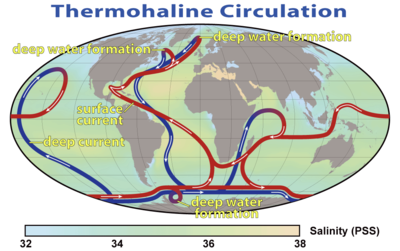From Wikipedia, the free encyclopedia
See also: Runaway climate change and Avoiding dangerous climate change
An abrupt climate change occurs when the climate system is
forced to transition to a new state at a rate that is determined by the
climate system itself, and which is more rapid than the rate of change
of the external forcing.[1] Past events include the end of the Carboniferous Rainforest Collapse,[2] Younger Dryas,[3] Dansgaard-Oeschger events, and possibly also the Paleocene-Eocene thermal maximum.[4] The term is also used within the context of global warming
to describe sudden climate change that is detectable over the
time-scale of a human lifetime. One proposed reason for the observed
abrupt climate change is that feedback loops within the climate system both enhance small perturbations and cause a variety of stable states.[5]Timescales of events described as 'abrupt' may vary dramatically. Changes recorded in the climate of Greenland at the end of the Younger Dryas, as measured by ice-cores, imply a sudden warming of +10°C within a timescale of a few years.[6] Other abrupt changes are the +4 °C on Greenland 11,270 years ago[7] or the abrupt +6 °C warming 22 000 years ago on Antarctica.[8] By contrast, the Paleocene-Eocene Thermal Maximum may have initiated anywhere between a few decades and several thousand years.
Contents
Definitions
According to the Committee on Abrupt Climate Change of the National Research Council:[1][9]There are essentially two definitions of abrupt climate change:
These definitions are complementary: the former gives some insight into how abrupt climate change comes about ; the latter explains why there is so much research devoted to it.
- In terms of physics, it is a transition of the climate system into a different mode on a time scale that is faster than the responsible forcing.
- In terms of impacts, "an abrupt change is one that takes place so rapidly and unexpectedly that human or natural systems have difficulty adapting to it".
Current situation
The IPCC states that global warming "could lead to some effects that are abrupt or irreversible".[10]In an article in Science, Alley et al. said "it is conceivable that human forcing of climate change is increasing the probability of large, abrupt events. Were such an event to recur, the economic and ecological impacts could be large and potentially serious."[11]
Regional changes
Lenton et al.[12] investigated tipping elements in the climate system. These were regional effects of global warming, some of which had abrupt onset and may therefore be regarded as abrupt climate change. They found that "Our synthesis of present knowledge suggests that a variety of tipping elements could reach their critical point within this century under anthropogenic climate change."Ocean effects
- Increasing frequency of El Niño events.[13][14]
- Potential disruption to [15] the thermohaline circulation, such as that which may have occurred during the Younger Dryas event.[16]
- Changes to the North Atlantic oscillation[17]
Climate feedback effects
See also: Runaway climate change
One source of abrupt climate change effects is a feedback
process, in which a warming event causes a change which leads to
further warming. This can also apply to cooling. Example of such feedback processes are:- Ice-albedo feedback, where the advance or retreat of ice cover alters the 'whiteness' of the earth, and its ability to absorb the sun's energy.[18]
- The dying and burning of forests, as a result of global warming.[19]
Past events
Several periods of abrupt climate change have been identified in the paleoclimatic record. Notable examples include:- About 25 climate shifts, called Dansgaard-Oeschger cycles, which have been identified in the ice core record during the glacial period over the past 100,000 years.[citation needed] The most recent of these events was the Younger Dryas which began 12,900 years ago and moved back into a warm-and-wet climate regime about 11,600 years ago.[citation needed]
- The Younger Dryas event, notably its sudden end. It has been suggested that: "The extreme rapidity of these changes in a variable that directly represents regional climate implies that the events at the end of the last glaciation may have been responses to some kind of threshold or trigger in the North Atlantic climate system."[20] A model for this event based on disruption to the thermohaline circulation has been supported by other studies.[16]
- The Paleocene-Eocene Thermal Maximum, timed at 55 million years ago, which may have been caused by the clathrate gun effect,[21] although potential alternative mechanisms have been identified.[22] This was associated with rapid ocean acidification[23]
- The Permian-Triassic Extinction Event, also known as the great dying, in which up to 95% of all species became extinct, has been hypothesized to be related to a rapid change in global climate.[24][25] Life on land took 30 million years to recover.[26]
- The Carboniferous Rainforest Collapse occurred 300 million years ago, at which time tropical rainforests were devastated by climate change. The cooler, drier climate had a severe effect on the biodiversity of amphibians, the primary form of vertebrate life on land.[2]
Abrupt climate shifts since 1976
Had the 1997 El Niño lasted twice as long, the rain forests of the Amazon basin and Southeast Asia could have quickly added much additional carbon dioxide to the air from burning and rotting,[29] with heat waves and extreme weather quickly felt around the world (The "Burn Locally, Crash Globally" scenario.[30])Most abrupt climate shifts, however, are likely due to sudden circulation shifts, analogous to a flood cutting a new river channel. The best-known examples are the several dozen shutdowns of the North Atlantic Ocean's Meridional Overturning Circulation during the last ice age, affecting climate worldwide.[11] But there have been a series of less dramatic abrupt climate shifts since 1976, along with some near misses.
- The circulation shift in the western Pacific in the winter of 1976-1977[31] proved to have much wider impacts.
- Since 1950, El Niňos had been weak and short, but La Niňas were often big and long, This pattern reversed after 1977.
- Land temperatures had remained relatively trendless from 1950 to 1976, despite the CO2 rising from 310 to 332 ppm as fossil fuel emissions tripled. Then in 1977 there was a marked shift in observed global mean surface temperature to a rising fever of about 2°C/century.[32]
- The expansion of the tropics from overheating is usually thought to be gradual, but the percentage of the land surface in the two most extreme classifications of drought suddenly doubled in 1982 and stayed there until 1997 when it jumped to triple (after six years, it stepped down to double).[33] While their inceptions correlate with the particularly large El Niňos of 1982 and 1997, the global drought steps far outlast the 13-month durations of those El Niňos.
- There were near-misses for "Burn Locally, Crash Globally" in Amazonia in 1998, 2005, and 2007, each with higher flammability than its predecessor.[29][34]
- There have also been two occasions when the Atlantic's Meridional Overturning Circulation lost a crucial safety factor. The Greenland Sea flushing at 75 °N shut down in 1978, recovering over the next decade.[35] Then the second-largest flushing site, the Labrador Sea, shut down in 1997[36] for ten years.[37] While shutdowns overlapping in time have not been seen during the fifty years of observation, previous total shutdowns had severe worldwide climate consequences.[11]
Consequential effects
The Permian–Triassic extinction event, labelled "P-Tr" here, is the most significant extinction event in this plot for marine genera.
- Mass extinctions in the past, most notably the Permian-Triassic Extinction event (often referred to as the great dying) and the Carboniferous Rainforest Collapse, have been suggested as a consequence of abrupt climate change.[2][26][38]
- Loss of biodiversity. Without interference from abrupt climate change and other extinction events the biodiversity of this planet would continue to grow.[39]
- Rapid Ocean acidification,[23] which can harm marine life (such as corals).[40]



No comments:
Post a Comment